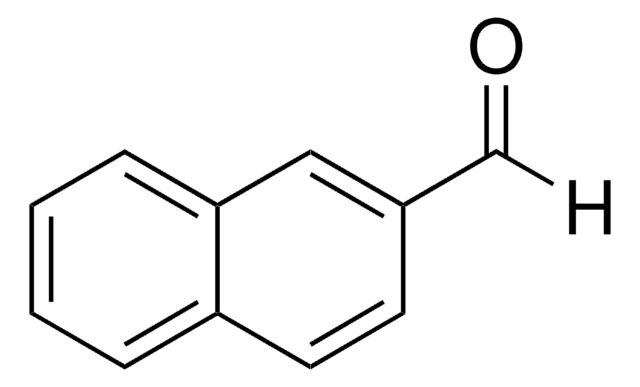70215
2,3-Naphthalenedicarboxaldehyde
suitable for fluorescence
Synonim(y):
NDA
About This Item
Polecane produkty
Postać
crystals
zanieczyszczenia
≤2% mono- and dicarboxylic acid (1H-NMR)
mp
131-133 °C (lit.)
132-135 °C
fluorescencja
λex 420 nm; λem ~480 nm in 0.1 M borate pH 9.3 (after derivatization with glycine [~90 μM glycine, ~20 μM N-])
przydatność
suitable for fluorescence
temp. przechowywania
2-8°C
ciąg SMILES
[H]C(=O)c1cc2ccccc2cc1C([H])=O
InChI
1S/C12H8O2/c13-7-11-5-9-3-1-2-4-10(9)6-12(11)8-14/h1-8H
Klucz InChI
ZIPLKLQPLOWLTM-UHFFFAOYSA-N
Szukasz podobnych produktów? Odwiedź Przewodnik dotyczący porównywania produktów
Opis ogólny
2,3-Naphthalenedicarboxaldehyde is a fluorescent derivatization agent of primary amines, amino acids, and small peptides. The reaction between the amino compounds and NDA results in highly fluorescent and stable derivative compounds.
Zastosowanie
Cechy i korzyści
- High Reaction rate.
- High Fluorescence quantum yield.
- No uncommon excitation wavelength.
- No side reactions.
Hasło ostrzegawcze
Warning
Zwroty wskazujące rodzaj zagrożenia
Zwroty wskazujące środki ostrożności
Klasyfikacja zagrożeń
Eye Irrit. 2 - Skin Irrit. 2 - STOT SE 3
Organy docelowe
Respiratory system
Kod klasy składowania
11 - Combustible Solids
Klasa zagrożenia wodnego (WGK)
WGK 3
Temperatura zapłonu (°F)
Not applicable
Temperatura zapłonu (°C)
Not applicable
Środki ochrony indywidualnej
dust mask type N95 (US), Eyeshields, Gloves
Certyfikaty analizy (CoA)
Poszukaj Certyfikaty analizy (CoA), wpisując numer partii/serii produktów. Numery serii i partii można znaleźć na etykiecie produktu po słowach „seria” lub „partia”.
Masz już ten produkt?
Dokumenty związane z niedawno zakupionymi produktami zostały zamieszczone w Bibliotece dokumentów.
Klienci oglądali również te produkty
Nasz zespół naukowców ma doświadczenie we wszystkich obszarach badań, w tym w naukach przyrodniczych, materiałoznawstwie, syntezie chemicznej, chromatografii, analityce i wielu innych dziedzinach.
Skontaktuj się z zespołem ds. pomocy technicznej




![1,8-Diazabicyclo[5.4.0]undec-7-ene 98%](/deepweb/assets/sigmaaldrich/product/structures/120/564/5b373e23-1624-489c-8efb-692de0f96ffb/640/5b373e23-1624-489c-8efb-692de0f96ffb.png)


![1,5,7-Triazabicyclo[4.4.0]dec-5-ene 98%](/deepweb/assets/sigmaaldrich/product/structures/171/446/333d560c-cff6-4958-b489-5acfb3057cce/640/333d560c-cff6-4958-b489-5acfb3057cce.png)






